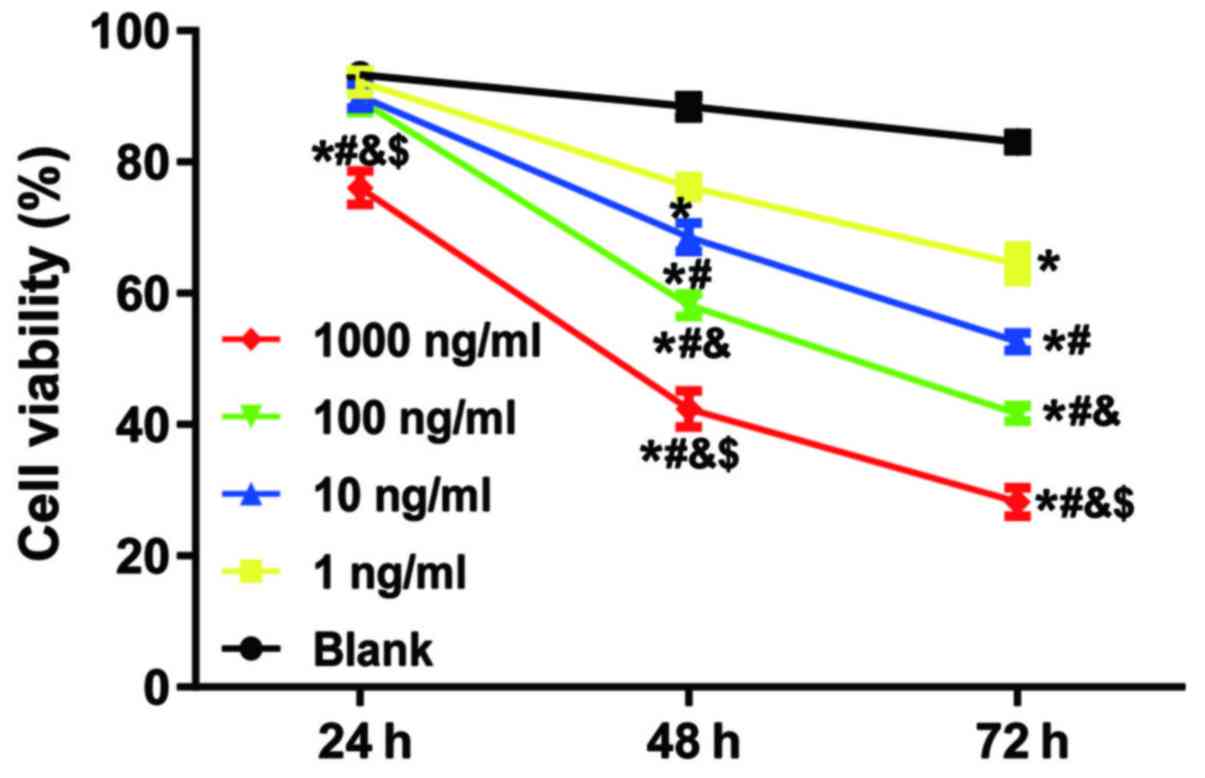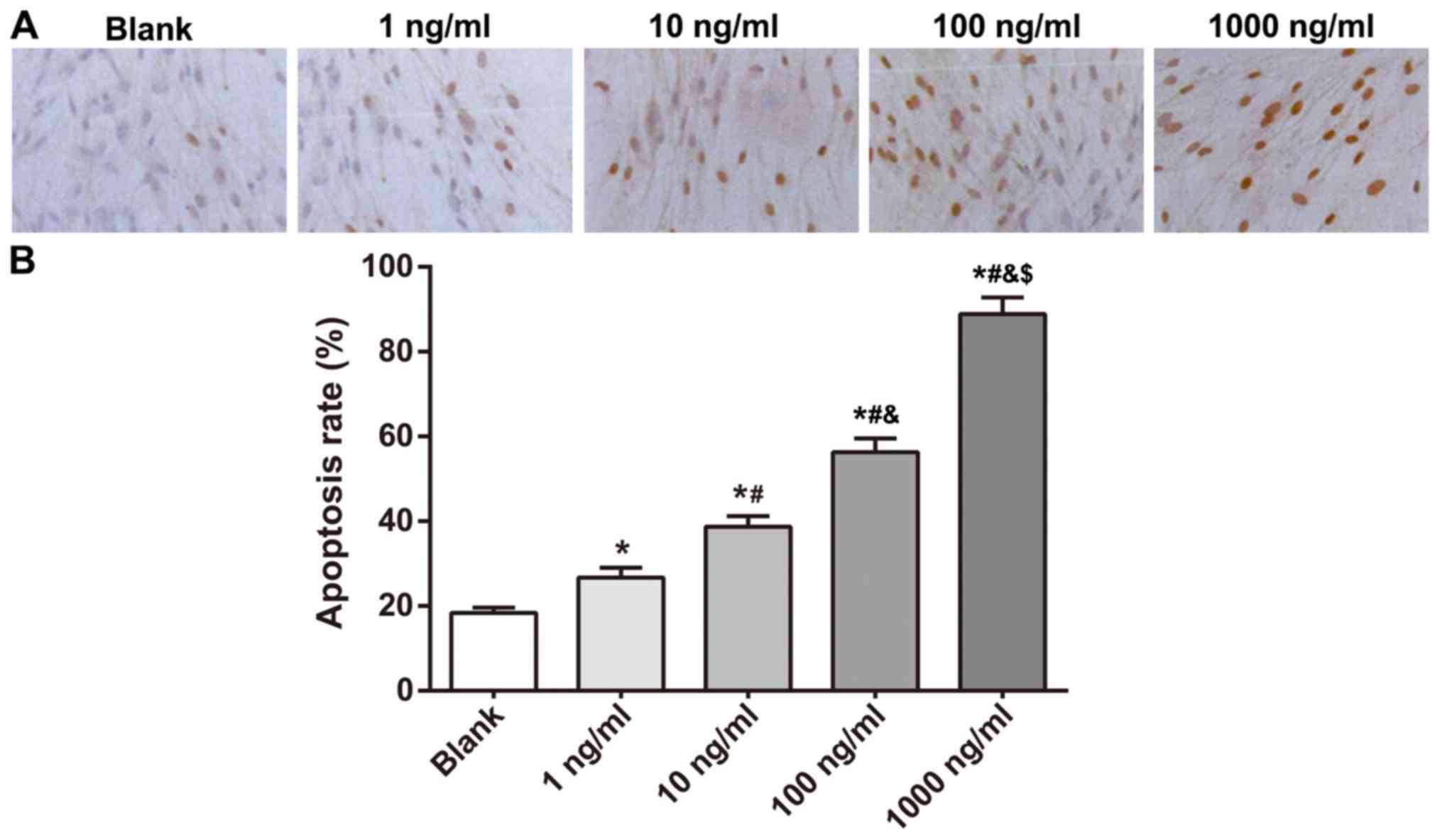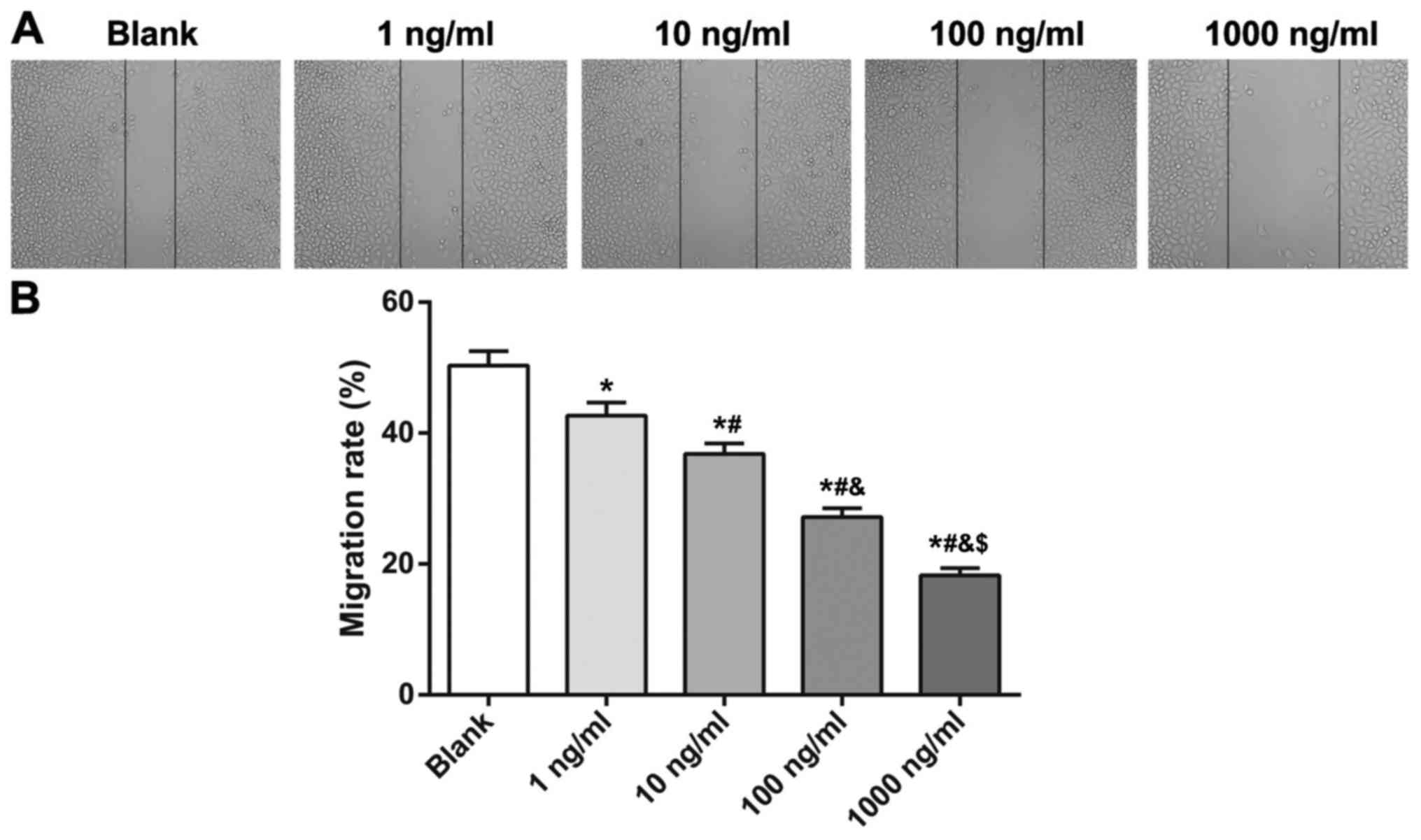|
1
|
Boscolo E, Limaye N, Huang L, Kang KT,
Soblet J, Uebelhoer M, Mendola A, Natynki M, Seront E, Dupont S, et
al: Rapamycin improves TIE2-mutated venous malformation in murine
model and human subjects. J Clin Invest. 125:3491–3504. 2015.
View Article : Google Scholar : PubMed/NCBI
|
|
2
|
Jia Y, Jia J and Zhao Y:
Pingyangmycin-regulated expressions of adhesion molecules in human
venous malformation endothelial cells. J Huazhong Univ Sci
Technolog Med. 32:760–766. 2012. View Article : Google Scholar
|
|
3
|
Zheng JW, Mai HM, Zhang L, Wang YA, Fan
XD, Su LX, Qin ZP, Yang YW, Jiang YH, Zhao YF and Suen JY:
Guidelines for the treatment of head and neck venous malformations.
Int J Clin Exp Med. 6:377–389. 2013.PubMed/NCBI
|
|
4
|
Wang Y, Qi F and Gu J: Endothelial cell
culture of intramuscular venous malformation and its invasive
behavior related to matrix metalloproteinase-9. Plast Reconstr
Surg. 123:1419–1430. 2009. View Article : Google Scholar : PubMed/NCBI
|
|
5
|
Buckmiller LM, Richter GT and Suen JY:
Diagnosis and management of hemangiomas and vascular malformations
of the head and neck. Oral Dis. 16:405–418. 2010. View Article : Google Scholar : PubMed/NCBI
|
|
6
|
Legiehn GM and Heran MK: Venous
malformations: Classification, development, diagnosis, and
interventional radiologic management. Radiol Clin North Am.
46:545–597, vi. 2008. View Article : Google Scholar : PubMed/NCBI
|
|
7
|
McRae MY, Adams S, Pereira J, Parsi K and
Wargon O: Venous malformations: Clinical course and management of
vascular birthmark clinic cases. Australas J Dermatol. 54:22–30.
2013. View Article : Google Scholar : PubMed/NCBI
|
|
8
|
Dompmartin A, Vikkula M and Boon LM:
Venous malformation: Update on aetiopathogenesis, diagnosis and
management. Phlebology. 25:224–235. 2010. View Article : Google Scholar : PubMed/NCBI
|
|
9
|
Lackner H, Karastaneva A, Schwinger W,
Benesch M, Sovinz P, Seidel M, Sperl D, Lanz S, Haxhija E, Reiterer
F, et al: Sirolimus for the treatment of children with various
complicated vascular anomalies. Eur J Pediatr. 174:1579–1584. 2015.
View Article : Google Scholar : PubMed/NCBI
|
|
10
|
Glade RS, Richter GT, James CA, Suen JY
and Buckmiller LM: Diagnosis and management of pediatric
cervicofacial venous malformations: Retrospective review from a
vascular anomalies center. Laryngoscope. 120:229–235.
2010.PubMed/NCBI
|
|
11
|
Lee AB, Laredo J and Neville R:
Embryological background of truncular venous malformation in the
extracranial venous pathways as the cause of chronic cerebro spinal
venous insufficiency. Int Angiol. 29:95–108. 2010.PubMed/NCBI
|
|
12
|
Malagelada C, Jin ZH, Jackson-Lewis V,
Przedborski S and Greene LA: Rapamycin protects against neuron
death in in vitro and in vivo models of Parkinson's disease. The J
Neurosci. 30:1166–1175. 2010. View Article : Google Scholar : PubMed/NCBI
|
|
13
|
Shafer A, Zhou C, Gehrig PA, Boggess JF
and Bae-Jump VL: Rapamycin potentiates the effects of paclitaxel in
endometrial cancer cells through inhibition of cell proliferation
and induction of apoptosis. Int J Cancer. 126:1144–1154.
2010.PubMed/NCBI
|
|
14
|
Zhao S, Huang D, Qi H, Wen J and Jia X:
Comparative metabolic profiling-based improvement of rapamycin
production by Streptomyces hygroscopicus. Appl Microbiol
Biotechnol. 97:5329–5341. 2013. View Article : Google Scholar : PubMed/NCBI
|
|
15
|
Huber TB, Walz G and Kuehn EW: mTOR and
rapamycin in the kidney: Signaling and therapeutic implications
beyond immunosuppression. Kidney Int. 79:502–511. 2011. View Article : Google Scholar : PubMed/NCBI
|
|
16
|
Nichols LA, Adang LA and Kedes DH:
Rapamycin blocks production of KSHV/HHV8: Insights into the
anti-tumor activity of an immunosuppressant drug. PLoS One.
6:e145352011. View Article : Google Scholar : PubMed/NCBI
|
|
17
|
Su W, Li Z, Jia Y and Zhuo Y: Rapamycin is
neuroprotective in a rat chronic hypertensive glaucoma model. PLoS
One. 9:e997192014. View Article : Google Scholar : PubMed/NCBI
|
|
18
|
Lamming DW, Ye L, Katajisto P, Goncalves
MD, Saitoh M, Stevens DM, Davis JG, Salmon AB, Richardson A, Ahima
RS, et al: Rapamycin-induced insulin resistance is mediated by
mTORC2 loss and uncoupled from longevity. Science. 335:1638–1643.
2012. View Article : Google Scholar : PubMed/NCBI
|
|
19
|
Zheng N, Ding X and Jahan R: Low
concentration of rapamycin inhibits hemangioma endothelial cell
proliferation, migration, and vascular tumor formation in mice.
Curr Ther Res Clin Exp. 76:99–103. 2014. View Article : Google Scholar : PubMed/NCBI
|
|
20
|
Wallez Y and Huber P: Endothelial adherens
and tight junctions in vascular homeostasis, inflammation and
angiogenesis. Biochim Biophys Acta. 1778:794–809. 2008. View Article : Google Scholar : PubMed/NCBI
|
|
21
|
DiStefano PV, Kuebel JM, Sarelius IH and
Glading AJ: KRIT1 protein depletion modifies endothelial cell
behavior via increased vascular endothelial growth factor (VEGF)
signaling. J Biol Chem. 289:33054–33065. 2014. View Article : Google Scholar : PubMed/NCBI
|
|
22
|
Richter GT and Friedman AB: Hemangiomas
and vascular malformations: Current theory and management. Int J
Pediatr. 2012:6456782012. View Article : Google Scholar : PubMed/NCBI
|
|
23
|
Sarbassov DD, Ali SM, Sengupta S, Sheen
JH, Hsu PP, Bagley AF, Markhard AL and Sabatini DM: Prolonged
rapamycin treatment inhibits mTORC2 assembly and Akt/PKB. Mol Cell.
22:159–168. 2006. View Article : Google Scholar : PubMed/NCBI
|
|
24
|
Guba M, von Breitenbuch P, Steinbauer M,
Koehl G, Flegel S, Hornung M, Bruns CJ, Zuelke C, Farkas S,
Anthuber M, et al: Rapamycin inhibits primary and metastatic tumor
growth by antiangiogenesis: Involvement of vascular endothelial
growth factor. Nat Med. 8:128–135. 2002. View Article : Google Scholar : PubMed/NCBI
|
|
25
|
Gluhovschi C, Gluhovschi G, Potencz E,
Herman D, Trandafirescu V, Petrica L, Velciov S, Bozdog G, Bob F,
Vernic C and Cioca D: The endothelial cell markers von Willebrand
factor (vWF), CD31 and CD34 are lost in glomerulonephritis and no
longer correlate with the morphological indices of glomerular
sclerosis, interstitial fibrosis, activity and chronicity. Folia
Histochem Cytobiol. 48:230–236. 2010. View Article : Google Scholar : PubMed/NCBI
|
|
26
|
Mohamed AS, Thomson J, McDonald KJ,
Hillyard DZ, Mark PB, Elliott HL and Jardine AG: Circulating
endothelial cells in renal transplant recipients. Transpl Proc.
37:2387–2390. 2005. View Article : Google Scholar
|
|
27
|
Humar R, Kiefer FN, Berns H, Resink TJ and
Battegay EJ: Hypoxia enhances vascular cell proliferation and
angiogenesis in vitro via rapamycin (mTOR)-dependent signaling.
FASEB J. 16:771–780. 2002. View Article : Google Scholar : PubMed/NCBI
|
|
28
|
Marqués L, Núñez-Córdoba JM, Aguado L,
Pretel M, Boixeda P, Nagore E, Baselga E and Redondo P: Topical
rapamycin combined with pulsed dye laser in the treatment of
capillary vascular malformations in Sturge-Weber syndrome: Phase
II, randomized, double-blind, intraindividual placebo-controlled
clinical trial. J Am Acad Dermatol. 72:151–158.e1. 2015. View Article : Google Scholar : PubMed/NCBI
|
|
29
|
Zhou C, Gehrig PA, Whang YE and Boggess
JF: Rapamycin inhibits telomerase activity by decreasing the hTERT
mRNA level in endometrial cancer cells. Mol Cancer Ther. 2:789–795.
2003.PubMed/NCBI
|
|
30
|
Nadal M, Giraudeau B, Tavernier E,
Jonville-Bera AP, Lorette G and Maruani A: Efficacy and safety of
mammalian target of rapamycin inhibitors in vascular anomalies: A
systematic review. Acta Derm Venereol. 96:448–452. 2016. View Article : Google Scholar : PubMed/NCBI
|
|
31
|
Shin S, Wolgamott L, Yu Y, Blenis J and
Yoon SO: Glycogen synthase kinase (GSK)-3 promotes p70 ribosomal
protein S6 kinase (p70S6K) activity and cell proliferation. Proc
Natl Acad Sci USA. 108:E1204–E1213. 2011. View Article : Google Scholar : PubMed/NCBI
|
|
32
|
Wilkinson JE, Burmeister L, Brooks SV,
Chan CC, Friedline S, Harrison DE, Hejtmancik JF, Nadon N, Strong
R, Wood LK, et al: Rapamycin slows aging in mice. Aging Cell.
11:675–682. 2012. View Article : Google Scholar : PubMed/NCBI
|
|
33
|
Visner GA, Lu F, Zhou H, Liu J, Kazemfar K
and Agarwal A: Rapamycin induces heme oxygenase-1 in human
pulmonary vascular cells: Implications in the antiproliferative
response to rapamycin. Circulation. 107:911–916. 2003. View Article : Google Scholar : PubMed/NCBI
|
|
34
|
Liu HT, Li F, Wang WY, Li XJ, Liu YM, Wang
RA, Guo WY and Wang HC: Rapamycin inhibits re-endothelialization
after percutaneous coronary intervention by impeding the
proliferation and migration of endothelial cells and inducing
apoptosis of endothelial progenitor cells. Tex Heart Inst J.
37:194–201. 2010.PubMed/NCBI
|
|
35
|
Moss SC, Lightell DJ Jr, Marx SO, Marks AR
and Woods TC: Rapamycin regulates endothelial cell migration
through regulation of the cyclin-dependent kinase inhibitor
p27Kip1. J Biol Chem. 285:11991–11997. 2010. View Article : Google Scholar : PubMed/NCBI
|
|
36
|
Shirazi F, Cohen C, Fried L and Arbiser
JL: Mammalian target of rapamycin (mTOR) is activated in cutaneous
vascular malformations in vivo. Lymphat Res Biol. 5:233–236. 2007.
View Article : Google Scholar : PubMed/NCBI
|
|
37
|
Barilli A, Visigalli R, Sala R, Gazzola
GC, Parolari A, Tremoli E, Bonomini S, Simon A, Closs EI, Dall'Asta
V and Bussolati O: In human endothelial cells rapamycin causes
mTORC2 inhibition and impairs cell viability and function.
Cardiovasc Res. 78:563–571. 2008. View Article : Google Scholar : PubMed/NCBI
|
|
38
|
Zhu W, Masaki T, Cheung AK and Kern SE:
In-vitro release of rapamycin from a thermosensitive polymer for
the inhibition of vascular smooth muscle cell proliferation. J
Bioequiv Availab. 1:3–12. 2009.PubMed/NCBI
|
|
39
|
Guo N, Chen F, Zhou J, Fang Y, Li H, Luo Y
and Zhang Y: Curcumin attenuates rapamycin-induced cell injury of
vascular endothelial cells. J Cardiovasc Pharmacol. 66:338–346.
2015. View Article : Google Scholar : PubMed/NCBI
|
|
40
|
Laurian C, Diner P, Enjolras O,
LeMarchand-Venencie F, Herbreteau D and Merland JJ: Surgical
treatment of superficial vascular malformations. Indications for
tissue expansion. J Des Maladies Vasculaires. 21:31–35. 1996.(In
French).
|



















